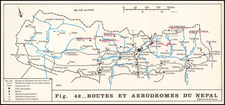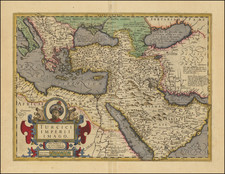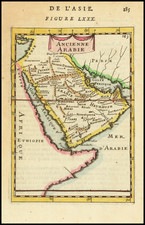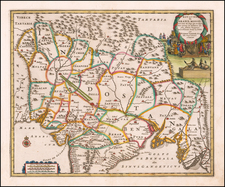Promoting The Work of America's Oldest Humantarian Organization
Rare pair of maps published by the Near East Relief (Near East Foundation).
While the maps themselves were understated in appearance, they are illustrative of the broad reach of the region impacted by the humanitarian crisis which the Foundation sought to address. The response of the Near East Relief to reports of “race extermination” against the Armenians, Assyrians, Greeks, and other Christian minorities of the Ottoman Empire is considered to be the United States’ first collective display of overseas humanitarian aid. In 15 years, NER would raise more than $116 million and mobilize hundreds of volunteers to help the effort.
Founded in 1915, the Near East Foundation is the United States’ oldest nonsectarian international development organization and the second American humanitarian organization to be chartered by an act of Congress. Near East Relief organized the world's first large-scale, modern humanitarian project in response to the unfolding Armenian and Assyrian genocides. Known as the Near East Foundation since 1930, NEF pioneered many of the strategies employed by the world’s leading development organizations.
These subtle understated maps were intended to educate Americans and illustrate the regions affected in response to Ambassador Henry Morgenthau Sr.’s reports of governmental atrocities, illustrating the locations of places which were likely remote and largely unknown to the vast majority of Americans and helping them to visualize the region and its Biblical history as a means of educating and persuading Americans to contribute to the cause.
Near East Relief / Near East Foundation
The Near East Foundation was founded in 1915 in response to Ambassador Henry Morgenthau Sr.’s reports of governmental atrocities against Ottoman Armenians. Morgenthau referenced the deportations of intellectuals and requested urgent and immediate assistance. Former missionary and educator James L. Barton and philanthropist Cleveland Hoadley Dodge led a group of prominent New Yorkers in forming the American Committee for Armenian and Syrian Relief (ACASR). ACASR then embarked upon an unprecedented grassroots campaign to raise money and awareness across the United States. The campaign combined striking imagery, passionate celebrity spokespeople, and captivating stories from the field to inspire Americans from all economic backgrounds to become citizen philanthropists. The organization also briefly used the name American Committee for Relief in the Near East in 1918–1919; that name appears on many of the Committee's most iconic posters.
In August 1919, the Committee received a Congressional charter (the second humanitarian organization to receive this recognition, after the American Red Cross) and was renamed Near East Relief. From 1915 to 1930, Near East Relief saved the lives of over a million refugees, including 132,000 orphans who were cared for and educated in Near East Relief orphanages. Near East Relief also mobilized the American people to raise over $116 million for direct relief. Nearly 1,000 U.S. citizens volunteered to travel overseas. Near East Relief workers built hundreds of orphanages, vocational schools, and food distributions centers. Overseas relief workers were responsible for the direct care of orphans and refugees, including the organization of vast feeding and educational programs. Thousands of Americans volunteered throughout the U.S. by donating money or supplies and hosting special events to benefit Near East Relief’s work.
The organization created the International Near East Association, which then dedicated Sunday, December 2, 1923, as an International Sunday of the Golden Rule. The “Golden Rule Sunday” as it became known, encouraged people to eat something simple—namely staple menus typically served in orphanages—and offer the money they saved as a donation to the orphans of the Armenian Genocide. The Sunday of the Golden Rule was celebrated in many parts of Europe, Australia, and America. President Calvin Coolidge urged the American people to express a spirit of sacrifice and generosity on December 2, 1923 as part of the larger philanthropic effort.
In 1930, Near East Relief was renamed the Near East Foundation (NEF) to reflect the organization's shift in focus from emergency relief to long-term social and economic development. NEF expanded its geographic focus to include North Africa, sub-Saharan Africa, and the area now known as the Middle East. NEF launched the Near East Relief Historical Society in 2014 in an effort to preserve and share the organization’s history.
Rarity
We were unable to locate any other examples of these two maps.












![(Silk Route Region / Western China) [Octava Asie Tabula]](https://storage.googleapis.com/raremaps/img/small/84174.jpg)

![[Iskenderun] The Gulf of Alexandretta or Scandaroon](https://storage.googleapis.com/raremaps/img/small/73675.jpg)

